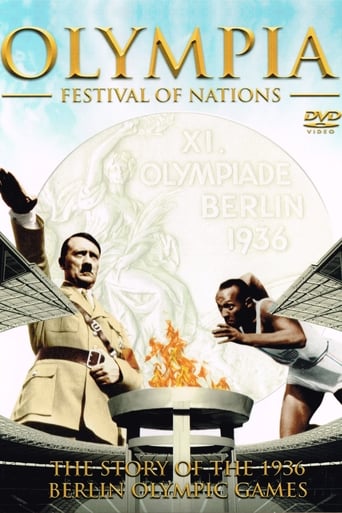peapulation
Whether you think Leni Riefenstahl was a Nazi or not, nobody can deny that she does take a neutral stance in this film. Indeed, it is surprising to hear the American national anthem being played in a German film of the Nazi era. Another gem in the film is to see Leni quietly glorifying the figure of black American athlete Jesse Owens, who famously disappointed Hitler by winning 'too many' medals for his taste. She looks at him as an athlete, and observes his cyborg-like body. When Jesse wins, the people whistle, but that's not important, as the American national anthem will cover them off.There is no doubt, the strength of this film is the cinematography. Riefenstahl did in Germany what Vertov did in Russia, only her style comes closer to today's tele-reportage than the Russian's. There are other fundamental differences between the two.Olympia as a whole (part I and 2) stands proudly. Yet, although the real trick was to film the actual footage as it happened, using pioneer effects of slow motion, fast motion and precise framing, the good stuff is found in the recreations, particularly at the start of part II, which portrays a 'gods-like temple' where the athletes relax in sight of their following tests.It's an admirable work, but as a lot of the old cinema, it is outdated. While 'Triumph of the Will' really wasn't as much (possibly because it's easier to plan an event that takes place in a shorter time, such as the Nuremberg Rally, as a lengthy event like the Olympic games), Olympia is lengthy, and overall, not an easy watch. In some bits, it's hard not to be tempted by the fast forward button on the remote control. But there is no denying that this is another testimony of Leni Riefenstahl's often underrated and mostly willingly obscured influence.
Boba_Fett1138
Since the 1936 Olympics was pretty much one big propaganda event for Hitler-Germany, this documentary about it can also be seen as a piece of propaganda. You could say that it's just a recording of the event and it doesn't glorify Hitler and Nazism. It show a bit too much of Hitler and his friends than really necessary and it glorifies the German athletes more with its images than with most other athletes is the case. The 1936 were used as a medium to show the supremacy of the Aryan race and show the German athletes as Übermenschen.Besides being known as the Nazi-propaganda Olympics, the 1936 Olympics are of course also known as the Olympics of Jesse Owens. The black American who won 4 golden medals. A clear booing and whistling can also been heard during the first running that he won and during some of his other wins and attempts, while all other athletes got cheered at, no matter were they were from. This didn't only happened to Jesse Owens though, since he of course wasn't the only black athlete at the Olympics who won a medal.They didn't used only footage from the actual Olympics but some of the images were obviously added later into it. I'm not just talking about the movie its intro but also of the actual sporting events. This can be the drop of a spear or discuss and things like that. It's obvious that it's all added later and that the movie is edited in such a way that it's obvious that at times the crowd reactions and all don't really go with the images but for artistic reason it obviously works out well for the movie. It often gives the movie some diversity and more pace as well.The documentary shows the most important attempts and athletes and of course the wins of all events. It often uses multiple camera-angels for this and some slow-motion as well.There is no denying in it that Leni Riefenstahl was a very talented documentary maker though it of course it remains a shame that she mostly used her talent for making Nazi propaganda pieces, despite always having denied she was a Nazi sympathizer herself. It gives her documentaries a bit of a bitter taste, no matter how technical well made and revolutionary they all are. She gets very much appreciated and recognized as a pioneer in documentary making but she also gets hated at the same time. It doesn't really make her documentaries any less great to watch though. It's always something beautiful, renewing and just unforgettable.8/10http://bobafett1138.blogspot.com/
gbheron
I must admit I don't get it. Reviewers and commenters lavish praise on the brilliant cinematography employed by Ms. Reifenstahl in filming the 1936 Olympics. She is supposed to have poured years of her life into her two-part documentary (this film is part one). Nowadays the NFL puts out weekly and yearly highlight films, and the only difference I see is that one is black and white, the other in colour. For me this is standard documentary, and that's all. My recommendation is that if you do not consider yourself a highbrow film connoisseur or are not interested in the 1936 Olympics this movie may bore you.
bigboy-8
I first viewed this film at the Museum of Modern Art 35 years ago;I now own it and the years have only added to my astonishment of what a genius Leni is. She took film to a new and higher art form. The Nazi noise does get in the way, but the epic scope and feel of the finished product make it worth viewing. And yes, part one is far superior, but part two is certainly a work of art also. It is a masterpiece. Would that she had done more. She is a most fascinating artist.





